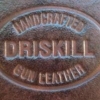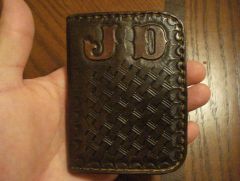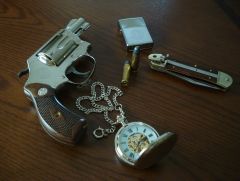-
Posts
120 -
Joined
-
Last visited
Content Type
Profiles
Forums
Events
Blogs
Gallery
Everything posted by BanjoMan
-
-
Particle, here are a few pictures of a badge holder that I made for a 6 point star. I usually put a metal belt clip on the back, but I needed something that would fit over a custom gun belt that is about 1/4" thick so I went with a belt loop. If you go to my gallery, you can see pictures of other badge holders that I have made also. The only way I can get them just right is if I have the badge to go by when making the holder. As far as the belt clip compared to the belt loop, it's a matter of personal preference. I hope this helps! Here are a few more pics of the belt clip style.
-

Need Help With Dyes And Finishes
BanjoMan replied to BanjoMan's topic in Gun Holsters, Rifle Slings and Knife Sheathes
Thanks for all the useful info everybody! I just received my order of Fiebing's from Tandy and I'm gonna try it today. Bigriver, how is the gloss on the angelus compared to super sheen? I'm looking for a finish with little to no gloss. -

Let's See Your Maker's Mark
BanjoMan replied to gregintenn's topic in Gun Holsters, Rifle Slings and Knife Sheathes
Since we're on the topic, where is the best place to have a custom maker's stamp made? I'm in the market! -
I am fairly new to leatherwork and need some good advice on what dye and finish I need to use to get the results I want. I am making holsters, wallets, badge holders and related items and I need a durable finish. Up to this point, I have been using Tandy eco-flo water based dye and satin sheen finish. It has worked out all right with the brown and tan, but the black did not penetrate very well. After SEVERAL coats it still looked dark brown. I am ready to switch to a higher quality dye, but I don't know where to start. I have heard a lot of good things about Fiebing's, but they have several options to choose from. What is the difference between the regular dye and the oil dye? Also, what Fiebing's finish is best to use. I want something that is permanent and waterproof but I DO NOT want a high gloss. I am not equipped to spray a finish on, so I need something that can be applied with either wool daubers or a sponge. I know that this is a lot to ask at once, but I just need a starting point!
-
I am fairly new to leatherwork and need some good advice on what dye and finish I need to use to get the results I want. I am making holsters, wallets, badge holders and related items and I need a durable finish. Up to this point, I have been using Tandy eco-flo water based dye and satin sheen finish. It has worked out all right with the brown and tan, but the black did not penetrate very well. After SEVERAL coats it still looked dark brown. I am ready to switch to a higher quality dye, but I don't know where to start. I have heard a lot of good things about Fiebing's, but they have several options to choose from. What is the difference between the regular dye and the oil dye? Also, what Fiebing's finish is best to use. I want something that is permanent and waterproof but I DO NOT want a high gloss. I am not equipped to spray a finish on, so I need something that can be applied with either wool daubers or a sponge. I know that this is a lot to ask at once, but I just need a starting point!
-
Thanks for the clarification, Leather Bum. I need to learn more about thread types. The belt, holster, and badge holder were actually all hand stitched using artificial sinew. I am curious about different thread options for hand stitching, though. I like how the sinew feels, looks, and stitches but I don't know how well it will hold up over time. Is there anything else you would reccomend for hand stitching?
-
I am still fairly new to leather work an I just got a new round knife for Christmas. Up to this point, I've been using sheers and an x-acto knife to cut leather for my projects. I would really like to start using the round knife, but I want to learn how to use it properly. On all of the videos where I've seen one used, it seems like it cuts much better and easier than any other method. Does anyone have any suggestions on where I should start as far as learning goes? (books, DVD's, tutorials, etc...??) Thanks!
-
I am still fairly new to leather work an I just got a new round knife for Christmas. Up to this point, I've been using sheers and an x-acto knife to cut leather for my projects. I would really like to start using the round knife, but I want to learn how to use it properly. On all of the videos where I've seen one used, it seems like it cuts much better and easier than any other method. Does anyone have any suggestions on where I should start as far as learning goes? (books, DVD's, tutorials, etc...??) Thanks!
-
Ken, as a matter of fact I do. I play banjo, guitar, mandolin, bass, and I mess with the fiddle a littlebut just don't have the extra time to spend on it. In my opinion, bluegrass is the best music in the world! We have a band and we play on a pretty regualar basis. We've been playing for about 8 years now and we do mostly local stuff including churches, festivals, partys, just whatever comes up. I've only been working with leather for a few months and have already developed a love for it. I guess it's kind of like bluegrass music in that it's something that's been around for a long time and not many people do it. If people like us didn't take the time and interest to learn in than it would probably just die out. I think that's what attracts me to stuff like this. I initially wanted to learn how to work with leather in order to make handgun holsters, but I have also thought about instrument straps. Do you have any pictures of straps that you have made? I'd reallly like to give it a try and it would be helpful to see some that someone else who knows what they're doing has made.
-

What Makes A Good Gun Belt?
BanjoMan replied to CrashInBlack's topic in Gun Holsters, Rifle Slings and Knife Sheathes
CrashinBlack, im my opinion width and thickness are equally important in a good gun belt. I've seen them range from 1" to 2", with 1 1/2" wide being the most common. If you're going for more of a "dressy" look then a narrow belt would look better but...the more narrow the belt is the more likely it will be to roll out when carrying a loaded full size handgun. I think the 1 1/2" belt is the most versatile as far as width goes. It seems to be wide enough to support a holster and weapon, but it still has the look of a normal belt to the untrained eye. Regardless, your holster is only as good as your belt and I am yet to find a plain store bought belt that is strong enough to do the job! -
Thanks Tac! It took a few tries with posterboard to get the holster just right, but I finally got it like I wanted it. As far as the pigskin goes, I don't know if glazed and veg-tanned are one in the same but I really like the look of it. It seems pretty strong and it has a grain side that I was able to use as the interior for a really clean look, so I am pleased with it. Thanks again for the compliments!
-
Thanks MikTigger! The grips are actually factory S&W believe it or not. They are the checkered walnut option. The knife is a Hubertis german made switchblade. The watch is a wedding gift from my wife. She also sent the gun and the zippo to a local jeweler and had him engrave my monogram into both items. I rarely ever carry any of this because I am scared that I will scratch the finish! I know that sounds lame, but it is kind of sentimental I guess. I've been trying to get around to making a nice custom holster for the gun for when I do decide to take it out. Thanks again!
-

What Makes A Good Gun Belt?
BanjoMan replied to CrashInBlack's topic in Gun Holsters, Rifle Slings and Knife Sheathes
I just completed a gun belt that I am pretty satisfied with. I used two pieces of 1 1/2" wide leather, approx. 8 oz. each, that I purchased already cut from Tandy. I just glued them together and hand stitched them to make one, then dyed front and back and installed hardware. I am pleased with it, but don't know if I'll do it again any time soon. The hand stitching took a REALLY long time, but if you have a sewing machine it would not be as bad. It turned out to be just over 1/4" thick, which is a little bulky but supports a loaded gun in a pancake holster really well. Next time I may try Haystackers idea and just use one thicker peice of leather as opposed to stitching two together. -
Thanks for the compliments, Chillybean! I know what you mean about getting tools together...I feel like you could do this for years and still not have everything that you need! I guess it just comes with time...good luck getting started! If you're anything like me, then you've probably already figured out that leatherwork is addictive. Merry Christmas!
-
Thanks for the compliments Mike and Haystacker! Like I said, I'm new to this and am still trying to work out the bugs, so it's good to get some positive feedback. Haystacker, as far as lining holsters goes I've heard the same thing. Some people even say that no lining is better because the flesh side of the leather will naturally burnish with use at all of the contact points on the inside. I considered using a 1 1/2-2 oz. veg tannned leather for the lining, but you can get pigskin for a fraction of the price. My main concern is that it will weaken and eventually tear over time. I guess if it does I can just consider that a lesson learned! Thanks again for the compliments and the advice!
-

What Do You Use For Boning?
BanjoMan replied to Sixer's topic in Gun Holsters, Rifle Slings and Knife Sheathes
Jeff has a good point. I've found that sometimes having the correct amount of moisture in the leather is more important than the tool you are using to bone. As far as tools, I've used a number of things that work well. I've had great results using the wooden handle end of one of my tools such as a overstitch wheel, edge beveler, etc. The trick is to roll it instead of rubbing it against the leather. As with any tool, if you rub too much you can burnish the leather and potentially leave a mark that will cause discoloration when dying. Just get your moisture content right, then try whatever you can get your hands on to mold with. You'll be surprised at work will work! Holsters look good by the way! -
This is a pancake holster for a Glock 22, a belt, and a badge holder that I recently completed. The holster is made of 8 oz. veg. tanned leather and is lined with glazed pigskin. It is hand stitched and hand boned. The belt is made of 2 belt blanks (approx. 8 oz. each) that have been hand stitched together to make one strip for added strength. The badge holder is made of 2 seperate pieces, the front piece with a recess to allow the badge to sit flush with the face to prevent snagging. It also has a metal belt clip on the back. All items were dyed with Tandy eco-flo cocoa brown and finished with satin shene. I used a stitching groover on all items prior to stitching and the edges of the holster were beveled front and back. The saddle stitching was done with natural color artificial sinew. I am fairly new to holster making and I still have a lot to learn, so ANY input would be appreciated. Thanks!
-
-
From the album: Random pics
© © leatherworker.net
-
-
From the album: Random pics
© © leatherworker.net
-












